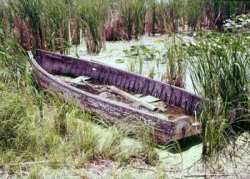 |
 |
| Home | Welcome | What's New | Site Map | Glossary | Weather Doctor Amazon Store | Book Store | Accolades | Email Us |
 | |||||||||
Weather Almanac for January 1999THE NORTH WIND DOTH BLOW"Upon retiring for the night, I tried to blow out the candle," a Winnipeg, Manitoba settler wrote in his diary one cold winter night in 1879, "But the flame was frozen, so I had to break it off." Although the settler spun the cold truth a little loosely, the depth of January cold is infamous across North America. That is not to say that North America has a monopoly on cold weather in the Northern Hemisphere. The very name Siberia conjures images of frigid cold, ice, snow and blizzard winds. But North America is unique among the arctic continents because the major mountain chains run north-south rather than east-west as in Europe (the Alps) and Asia (the Himalayas). This makes nearly all of North America susceptible to vigorous cold fronts. Without the mountain barriers to block them, Arctic cold outbreaks can sweep southward toward the subtropical Gulf of Mexico, even crossing its waters on occasion.
As the air cools, it becomes denser, forming large domes of high pressure. Eventually, this cold dome breaks its bond with the spawning ground and rushes wildly southward. Howling winds precede the great dome, announcing its advent to all life. Trees shudder. Birds shiver. Rabbits burrow deep within snow banks. As many a Texas Panhandle farmer has worried: "The only thing standing between us and the North Pole is a three-strand barb wire fence. And I fear one strand is missing." Before they knew the science behind the weather, inhabitants of the northern latitudes heard the voices of gods and demons in the howling rush of frigid, cold air from the polar region. The Greeks personified the North Wind as an old man, grey of locks but strong in body and harsh in disposition. They called him Boreas. The Apache saw the wind as a black wind, the Irish saw dark grey. To the Egyptians the north wind was Bai, the ram. To the Algonquin Nation, he was Kibibonokko, the fierce one. Boreas has many relatives: the twin brothers Norther of the Texas Panhandle and Blue Norther of Alberta; an uncle from Greenland, Nekrayak; the Siberian cousins Viugas, Purgas and Myatel; the Asian Steppe-sisters, Steppenwind and Buran; the Scottish nephews Blaast and Landlash; and the American blood brothers, Arctic Screamer, Stikine and Blizzard. But the one Boreal relative I remember most is the Barber, the freezing wind that quickly ices beards and hair. I call such frozen moisture forming on my mustache and beard in the frigid air: winter pearls. I have never experienced a Siberian cold blast -- watching the movie Doctor Zhivago was cold enough for me -- but I have experienced Arctic Screamers and Barbers descending across the Great Lakes region. My most lasting memory of January cold occurred during the severe winter of 1976-77. Temperatures in southwestern Ontario that month dropped to minus 30° C (-22° F), ushered in on winds howling over the white landscape at speeds of 40 km/hr (25 mph) with gusts at times reaching 70 km/hr (44 mph). As the winds raged across the dry snow blanketing the countryside, it caused blizzard conditions and white-outs for days on end. I vividly remember being caught one evening on foot during white-out conditions. Despite my hooded parka, winter pearls clung tightly to my bearded face. I had to keep opening my mouth wide to break the ice buildup before it could freeze shut. The driving snow was less a snow storm, since none seemed to be coming from the heavens, and more of an ice-dust storm. The turbulent winds drove the snow off the ground and pulverized the crystals into fine needles. As they swirled into the air, the whole surrounding landscape was obliterated from view.
Ice crystals stung those few areas where my face flesh was exposed to the elements, tiny slivers attacking my face like a swarm of fire ants. My nose and sinuses ached from the icy touch of the cold metal of my glasses frame. Instinctively, I rolled my hands into tight fists to keep some warmth in my fingers. Only the crackling of ice crystals beating against my parka hood broke the encompassing silence. All the while I was being attacked by ice splinters, the gusting gale shook me like a mortal foe trying to shake the life out of me. After a few minutes, although it seemed like hours, winter's fist unclenched momentarily. The wind lulled briefly, shifted direction slightly and pushed the white-out plume away from me. But as quickly as it had stopped, the flying snow and buffeting winds began again. Although the visible world again emerged around me, the north wind continued to blow unabated, moaning in dark humour. WE SOON SHALL HAVE SNOW.Learn More From These Relevant Books
|
|||||||||
 |
To Purchase Notecard, |
Now Available! Order Today! | |
 |
 |
NEW! Now |
The BC Weather Book: |


